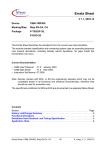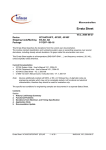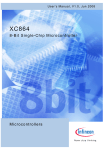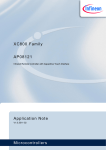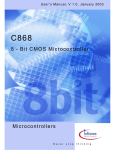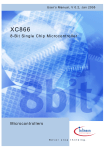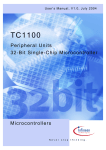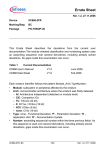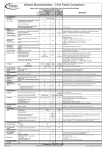Download C868 BA (SRAM) Errata Sheet
Transcript
Errata Sheet V 1.4, 2003-12 Device C868-1SR/SG, C868P-1SR Marking/Step Step ES-BA, BA Package P-TSSOP-38, P-DSO-28 This Errata Sheet describes the deviations from the current user documentation. The module oriented classification and numbering system uses an ascending sequence over several derivatives, including already solved deviations. So gaps inside this enumeration can occur. Current Documentation • C868 User's Manual V1.0 January 2003 • C868 Data Sheet V1.0 May 2003 • Instruction Set Manual 07.2000 Note: Devices marked with EES- or ES are engineering samples which may not be completely tested in all functional and electrical characteristics, therefore they should be used for evaluation only. The specific test conditions for EES and ES are documented in a separate Status Sheet. Contents Section . . . . . . . . . . . . . . . . . . . . . . . . . . . . . . . . . . . . . . . . . . . . . . . . . . . . . . . . . . Page History List/Change Summary . . . . . . . . . . . . . . . . . . . . . . . . . . . . . . . . . . . . . . . . . .2 Functional Deviations . . . . . . . . . . . . . . . . . . . . . . . . . . . . . . . . . . . . . . . . . . . . . . . . .4 Deviations from Electrical- and Timing Specification. . . . . . . . . . . . . . . . . . . . . . . .6 Application Hints . . . . . . . . . . . . . . . . . . . . . . . . . . . . . . . . . . . . . . . . . . . . . . . . . . . . .7 Errata Sheet, C868-1SR/SG, C868P-1SR, Step ES-BA, BA 1/7 K. Yang, V 1.4, 2003-12 Errata Sheet History List/Change Summary 1 History List/Change Summary (since last CPU Step ES-0204, previous Errata Sheet V1.3) Device C868-1SR/SG Table 1 Functional Deviations Functional Deviation Short Description CCU.1 CCU interrupts do not participate in the arbitration of MCU and might be masked by other interrupts. CCU.2 T12 Shadow Transfer for Phase Delay Function. ADC.1 Selection of ADC conversion by hardware by just writing a '1' to 'CCU_ADEX' bit does not work. SYS.1 Watchdog, PLL or Brownout Reset results in a return to starting address of Bootstrap code after jumping from Bootstrap Mode. SYS.2 Brownout (BO) threshold level is too low Table 2 AC/DC Deviations AC/DC Deviation Short Description Fixed Change in Step BA New Fixed Change in Step None Table 3 Application Hints Application Hint Short Description WDT.H1 Watchdog Timer (WDT) status in the Bootstrap Mode. Updated PD.H1 After wakeup from power down PLL might unlock if oscillator startup is long. Updated Errata Sheet, C868-1SR/SG, C868P-1SR, Step ES-BA, BA Fixed Change in Step 2/7 K. Yang, V 1.4, 2003-12 Errata Sheet History List/Change Summary Device C868P-1SR Table 4 Functional Deviations Functional Deviation Short Description CCU.1 CCU interrupts do not participate in the arbitration of MCU and might be masked by other interrupts. CCU.2 T12 Shadow Transfer for Phase Delay Function. ADC.1 Selection of ADC conversion by hardware by just writing a '1' to 'CCU_ADEX' bit does not work. SYS.1 Watchdog, PLL or Brownout Reset results in a return to starting address of Bootstrap code after jumping from Bootstrap Mode. SYS.2 Brownout (BO) threshold level is too low Table 5 AC/DC Deviations AC/DC Deviation Short Description Fixed Change in Step BA BA New Fixed Change in Step None Table 6 Application Hints Application Hint Short Description PD.H1 After wakeup from power down PLL might unlock if oscillator startup is long. Errata Sheet, C868-1SR/SG, C868P-1SR, Step ES-BA, BA Fixed Change in Step 3/7 Updated K. Yang, V 1.4, 2003-12 Errata Sheet Functional Deviations 2 Functional Deviations CCU.2: T12 Shadow Transfer for Phase Delay Function In Hall mode (T12MSELx = '1001'), T12 never reaches its period value in normal operation because a detected hall event on CCPOSx captures the actual T12 count value to CC60R (speed reference) and resets T12. But this period event is needed to trigger the shadow transfer of T12 register, i.e. an update of the timer registers (e.g. CC61R as variable phase delay) is not possible. The shadow transfer should be triggered together with the reset event of T12. Workaround: The shadow registers of T12 are transparent if the timer is stopped and if the shadow transfer is enabled (STE12=1). Therefore it is possible to write the new value to the shadow registers by enabling the shadow transfer, stopping T12 and starting T12 again. This is equivalent to a hardware triggered shadow transfer event. Inevitably, some clocks for the capture/compare events are lost in between the stop / start operation. It has to be noted that bit STE12 is cleared by hardware after a shadow transfer event. ADC.1: Selection of A/D conversion by hardware by just writing a ‘1’ to CCU_ADEX bit does not work. Selection of A/D conversion by hardware by just writing a ‘1’ to CCU_ADEX does not work. The analog input channel selection can only be latched when ‘ADST’ bit is set. So during hardware trigger mode, ‘ADST’ needs to be ‘1’ to select the input channel and ‘CCU_ADEX’ needs to be ‘1’ to select the conversion to be started by T13 period match event. Please note that when ‘ADST’ and ‘CCU_ADEX’ are both set at the same time (in one instruction), conversion is started by hardware. In case ‘ADST’ is set before ‘CCU_ADEX’, conversion is started immediately by software. Workaround: In software, set ‘ADST’, ‘CCU_ADEX’ at the same time together with the desired input channel selection to enable conversion triggered by T13PM. For example, MOV ADCON0, #8CH ; enable hardware triggered conversion for channel 4 Errata Sheet, C868-1SR/SG, C868P-1SR, Step ES-BA, BA 4/7 K. Yang, V 1.4, 2003-12 Errata Sheet Functional Deviations SYS.1: Watchdog, PLL or Brownout Reset results in a return to starting address of Bootstrap code after jumping from Bootstrap Mode Watchdog, PLL or Brownout reset results in a return to the starting address of Bootstrap code after jumping from bootstrap mode. This reset causes a jump to beginning of the Bootstrap rather than the SRAM space. The jump is based not on the BSLEN bit in SYSCON but the latched BSL bit from the previous hardware reset. After WDT, PLL or Brownout reset, the Bootstrap reloads the program. Workaround: After loading the program, BSL pin must be set to 'high' via a resistor, followed by an external hardware reset. In this way, WDT, PLL or Brownout reset will caused a jump to the beginning of the SRAM space. SYS.2: Brownout (BO) threshold level is too low The brownout (BO) threshold level is too low for a safe operation. It cannot be guaranteed that the device is working correctly down to such a low voltage. Thus the use of this feature is not encouraged. It must be kept disabled at all time by ensuring that bit SFR PMCON0.4 (EBO bit) is written with 0 only. The brownout detection section will be removed from future documentations. Workaround: None. Errata Sheet, C868-1SR/SG, C868P-1SR, Step ES-BA, BA 5/7 K. Yang, V 1.4, 2003-12 Errata Sheet Deviations from Electrical- and Timing Specification 3 Deviations from Electrical- and Timing Specification No deviations from the Electrical- and Timing Specification are known for this step. Errata Sheet, C868-1SR/SG, C868P-1SR, Step ES-BA, BA 6/7 K. Yang, V 1.4, 2003-12 Errata Sheet Application Hints 4 Application Hints WDT.H1: Watchdog Timer (WDT) status in Bootstrap Mode. For devices C868-1SR/SG starting from date code E244 onwards, the WDT is left in its default state (i.e. WDT is not disabled and the values of WDT is not locked by setting ENDINIT bit) at the very beginning of the Bootstrap mode. Once boot-up from bootstrap mode, it is up to the user to disable or leave the WDT running in the application, as per documentation. For devices C868-1SR/SG before date code E244, the WDT has been disabled in the bootstrap mode and cannot be enabled when boot-up from Bootstrap Mode. Thus the WDT does not run and does not generate a WDT reset. Note: This application hint is renamed as WDT.H1 Workaround: Not applicable. PD.H1: After wakeup from power down PLL might unlock if oscillator startup is long. In the User's Manual, it is stated that there will a period of start-up phase before PLL starts locking. Conversely, PLL starts to lock even during the start-up phase. And once the lock detection circuit has output an 'OK' signal, the program will start running. However, due to instability of start-up phase and inadequate lock detection period of 4096 clocks (153 us @ 10.67 MHz), PLL might unlock and generate a PLL-reset. This will cause a rebooting if BSL mode is enabled and therefore the wakeup process is corrupted. Note: This application hint is renamed as PD.H1 Workaround: Use a ceramic resonator instead of a crystal with a fast oscillator startup phase. Application Support Group, Singapore Errata Sheet, C868-1SR/SG, C868P-1SR, Step ES-BA, BA 7/7 K. Yang, V 1.4, 2003-12








